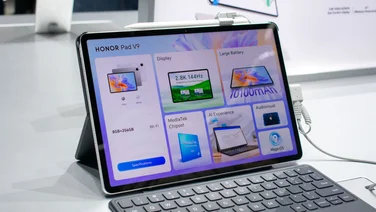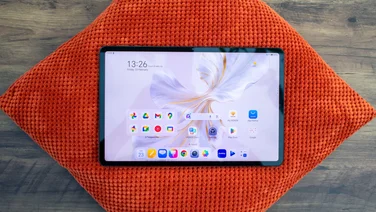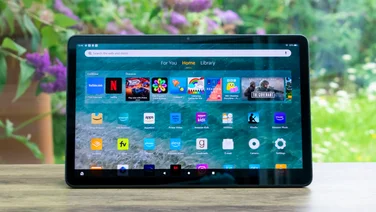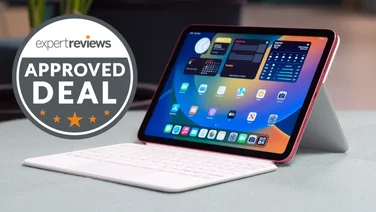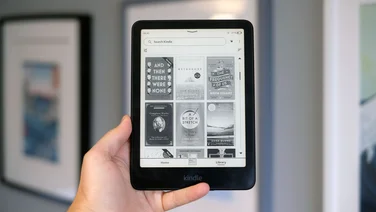To help us provide you with free impartial advice, we may earn a commission if you buy through links on our site. Learn more
- M1 Apple iPad 12.9in (2021) review: What you need to know
- M1 Apple iPad 12.9in (2021) review: Price and competition
- M1 Apple iPad Pro 12.9in (2021) review: Design and features
- M1 Apple iPad Pro 12.9in (2021) review: Liquid Retina XDR display
- M1 Apple iPad Pro 12.9in (2021) review: Battery life and performance
- M1 Apple iPad Pro 12.9in (2021) review: Software
- M1 Apple iPad Pro 12.9in (2021) review: Verdict











- Brilliant Mini-LED display
- M1 chip is very powerful
- Battery life still great
- Expensive once you add a keyboard
- iOS still has its frustrations
The iPad Pro has slowly matured into quite the powerhouse over the past few years, but its taken a giant leap forward in 2021. Adopting the much-lauded Apple M1 processor the same chip found inside this years 24in iMac, Mac mini, MacBook Pro and MacBook Air it has finally drawn level with its more serious counterparts when it comes to raw power.
Coupled with the advances that Apple has made to iOS, the latest iPad Pro more closely resembles a full-blown laptop alternative than it ever has before.
M1 Apple iPad 12.9in (2021) review: What you need to know
The M1 chip isnt the only big upgrade for the 2021 iPad Pro, either, despite the fact that it looks pretty much identical to the previous model. Next on the list of upgrades is the new Liquid Retina XDR display, which employs Mini-LED technology to boost its HDR capabilities, improving the visuals without the cost to peak brightness and battery life that OLED often brings with it.
Theres also 5G capability for those who cant face the inconvenience of tethering, an ultrawide front camera that can follow you around the room, Thunderbolt 3 connectivity and a new 2TB storage option, although the price of that is heart-stoppingly expensive.
Everything else, however, remains the same. You get two Pro cameras on the rear of the tablet one 12MP main, one 12MP ultrawide plus a LiDAR scanner for measuring things and using augmented reality (AR) apps. The keyboard is still a costly optional extra, although youd be mad to purchase an iPad Pro without one. And the Apple Pencil 2 is the same, too, although thats not as essential a purchase.
Its also available in the same two sizes as before 12.9in and 11in although take note: the smaller iPad Pro doesnt come with the revolutionary Mini-LED display.
M1 Apple iPad 12.9in (2021) review: Price and competition
As Ive already intimated, the iPad Pro should primarily be seen as a laptop alternative and, as such, thats the context in which Ive viewed it while sizing up the competition. This is a tablet you buy for work first, not pleasure.
The price dictates this approach as much as anything else and the iPad Pro sits firmly in premium laptop territory. Prices start at £999 for the 12.9in Wi-Fi model with 128GB of storage and £749 for the 11in model with 128GB of storage; the Smart Keyboard Folio adds a further £199 (£179 for the 11in) while the Magic Keyboard with touchpad adds £329 (£279 for the 11in). That brings the base price of the 12.9in iPad Pro up to £1,198 or £1,328 if you want the full laptop alternative experience.
The most obvious rival at these prices is the M1 MacBook Air. It doesnt have a Mini-LED display, a touchscreen or stylus support but, with prices starting at £999 for the 7-core GPU model with 256GB of storage, it looks a better-value alternative. In my opinion, macOS is a better fit for everyday work as well, with full support for second monitors, an area where iOS still suffers.
As for Windows laptops, theres a huge choice available at this price, from the ultralight Samsung Galaxy Book Pro from a very reasonable £1,099 to the luxurious and powerful Dell XPS 13, which starts at £1,249 for the latest 11th Gen Intel model (Core i5, 8GB RAM 256GB storage, non-touchscreen).
If you have your heart set on a touchscreen 2-in-1 detachable, then your best option is still the Microsoft Surface Pro 7, which comes in at a cheaper £984 with the keyboard (Intel Core i5, 8GB RAM, 256GB storage), although the CPU is one of Intels older, 10th-gen chips and cant match the Apple M1 in the iPad Pro.
The Samsung Galaxy Tab S7 Plus offers competitive hardware but Android still lacks the polish of iOS when it comes to using a tablet-based OS for work.
M1 Apple iPad Pro 12.9in (2021) review: Design and features
Despite all the upgrades, the physical design of the new iPad is no different from last years model. Its still available in Space Grey or Silver, measures 5.9mm thick and weighs 682g, or 1.4kg with the Magic Keyboard attached to it. The smaller 11in model weighs 468g for the tablet and 1.1kg with the Magic Keyboard.
You have a pair of cameras on the rear in the corner, in a square, raised housing like the one on Apples iPhone 12 range of smartphones. Beside it is the tablets LiDAR scanner, which is used to measure objects with the iOS Measure app and by some apps that use AR.
Also on the rear are three metal contacts for keyboard attachment, while around the edges youll find a single Thunderbolt 3 port, the volume and power buttons (in the upper left corner if you have the tablet in landscape orientation) plus four speaker grilles for the iPad Pros quad-speaker array. The audio output of the iPad Pros speakers remains among the best Ive listened to on any laptop, tablet, 2-in-1 or otherwise.











As before, the iPad Pro employs Face ID as its primary means of biometric authentication, which works as well as it ever did. The camera itself, however, has had an upgrade with the introduction of a feature called Centre Stage.
Simply put, Centre Stage uses the new 10.8MP 105-degree ultrawide front camera to keep your face centred in the frame during video calls. It works pretty well, panning left, right, up and down as you move about, and the range of movement its able to track is impressive. Its surprising how far off-centre you can move and still stay in frame.
Thats great, but the image quality is disappointing. Colours look good and the cameras HDR capabilities help it cope well with extremes of bright and dark in the frame, but theres plenty of image noise, no doubt amplified by the fact that the Centre Stage tracking only makes use of part of the sensor at any particular time.
READ NEXT: Our guide to the best iPads to buy
M1 Apple iPad Pro 12.9in (2021) review: Liquid Retina XDR display
There are no such caveats with the new Liquid Retina XDR display, which is, quite frankly, bonkers good. It measures 12.9in across the diagonal and has a resolution of 2,732 x 2,048, the same as last year, but this time it uses Mini-LED technology. Its similar to the IPS LED screen in last years iPad Pro but with many more of those LEDs in the backlight. The result is blindingly bright highlights and inky dark black-level response.
So why has Apple chosen not to go OLED? I can only assume that battery life and brightness each play a significant part. Most of the OLED displays weve seen on laptops have negatively impacted battery life, with the Samsung Galaxy Book Pros 1080p OLED screen proving the only exception.











Peak brightness also rarely reaches the same levels as it does with backlit LCD screens. You can compensate for that indoors by drawing the curtains but you cant do that when youre out and about, and that generally makes OLED displays an inferior choice in bright environments.
The iPad Pro 12.9ins Mini-LED display strikes the perfect compromise for me. The contrast ratio isnt perfect as it is on OLED screens I was able to observe the black level rising up to 0.17cd/m² in some circumstances but combined with a peak brightness of up to 1,600cd/m² with Dolby Vision HDR material and 1,000cd/m² at full-screen (thats genuinely, blindingly bright, by the way), it delivers a contrast ratio thats very nearly as good.
Alas, I dont have the facilities at hand to test the displays Dolby Vision capabilities but I was able to run tests in SDR and HDR10 on the screen, and the results were very impressive. First up, in the standard dynamic range tests, I found that, as per Apples claims, the display reached around 1,000cd/m², making it comfortably the brightest display Ive ever come across on any portable computer. Colour accuracy is fabulous, too, with the average Delta E (or colour difference from the colour intended) at a staggering 0.32. Thats essentially as good as it gets.











As for HDR10 material, that measures up well, too. Peak brightness again reached just over 1,000cd/m² and the colour accuracy was a solid 2.33. This translates to wondrously impactful playback of HDR movies and TV.
Sat side by side with the previous model, the differences arent night and day, but the images do have noticeably more solidity on the new iPad, and those black bars at the top and bottom of the screen fade into darker inconsequence. Nowhere is this more obvious than in the twilight world of Apple TV+s Earth at Night in Color series. Scenes shot in the dark have more impact, appear more luminous and pack more contrast than on the older tablet. The action simply looks more real and more present on the Mini-LED display.
And it compares favourably with the OLED panels that rivals are beginning to install on their premium laptops and tablets, too. The Samsung Galaxy Tab S7 Plus OLED screen, for example, may look glorious indoors but only reached a peak 367cd/m² in our tests. The iPad Pro 12.9in is nearly three times as bright and, as a result, is much more practical for working in bright conditions.
M1 Apple iPad Pro 12.9in (2021) review: Battery life and performance
Its also good to see that improvements to the display dont come at the expense of battery life, as they might have done had Apple chosen to go with OLED instead of Mini-LED. In our video rundown test, the M1 iPad Pro 12.9in lasted 11hrs 35mins before giving up the ghost.
It isnt as good as the MacBook Air, which lasted 14hrs 40mins in the same test, but thats hardly surprising given that the iPads battery is 40.9Whr versus the MacBook Airs 49.9Whr. Indeed, given the disparity in battery size, the M1 iPad Pro 12.9 performs pretty much as youd expect; perhaps even a mite better.

So the M1 processor is efficient; the question is, how much more powerful is it than the outgoing Apple A12X from 2020s iPad Pro? The answer is a lot. We already know from the MacBooks and Mac mini that the M1 is powerful enough to drive macOS and full-blown desktop software a leap forward only seen once in a generation and its the same here, although theres no big switch in architecture.
Lets put that into some visual perspective with a couple of graphs:


You can see that the M1 iPad Pro 12.9in (2021) performs roughly on a par with the MacBook Air but, compared with the previous iPad Pro 12.9in, its much, much quicker. It achieved a 56% higher score on average in the Geekbench 5 benchmark and a 45% higher frame rate in the demanding Car Chase GFXBench (offscreen) graphics test. The previous iPad was no slouch but the M1 machine is, quite simply, in a different league.
READ NEXT: Our guide to the best iPads to buy
M1 Apple iPad Pro 12.9in (2021) review: Software
Does this mean the M1 iPad Pro should be viewed in the same category as the M1 MacBook Air? After all, despite the difference in form factor, the hardware inside is, effectively, the same.
The answer is that its complicated.
Apple has certainly made big strides with iPad OS in the past few years and its no longer the pain it once was to do serious work on. With the Files app you can now perform simple file transfer operations and copy and paste stuff back and forth from external storage.
There are plenty of heavyweight apps available on the platform, too, from pro photo-editing apps such as Photoshop and Affinity Photo to high-end video-editing packages such as Luma Fusion. You can even connect a mouse and keyboard and use it like a regular PC.











The main issue that would prevent me from using an iPad for work full time is that it still doesnt have proper external monitor support. While you can connect a second screen to the iPads Thunderbolt 3 port, the only display option open to you currently is to duplicate whats shown on the screen of the iPad.
Theres no option to extend the space available and spread apps across two screens as you can with a MacBook or a Windows 10 laptop. And the fact that the Sidecar feature in macOS allows MacBooks and iMacs to use an iPad as a second monitor simply rubs salt into the wound.
This may change, of course, as Apple updates iOS over the coming months and years but, right now, its a serious hurdle to iOS and, by extension, the iPads professional aspirations.
M1 Apple iPad Pro 12.9in (2021) review: Verdict
Putting that aside for one moment, however, its quite clear that the iPad Pro 12.9in is a fabulous piece of hardware and categorically the best tablet you can buy. Its as powerful as the MacBook Air and MacBook Pro, it has great battery life for a device this compact and the new Mini-LED display tech puts it in a different league.
In many ways its as good as, if not better than, a traditional laptop. However, its being held back by silly restrictions like the inability to make full use of a second display and its eye-watering price. If you buy both the tablet and keyboard, its considerably more expensive than the equivalent Apple MacBook Air, although the iPad admittedly has a touchscreen and a far nicer display.
This is the dilemma that Apple must contend with now that it has brought the iPad to full parity with its laptop and desktop machines. Its fabulous hardware, no doubt, but its being held back from true greatness by the limitations of its software.

















